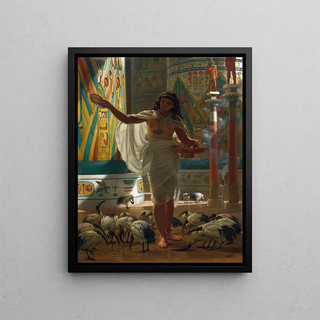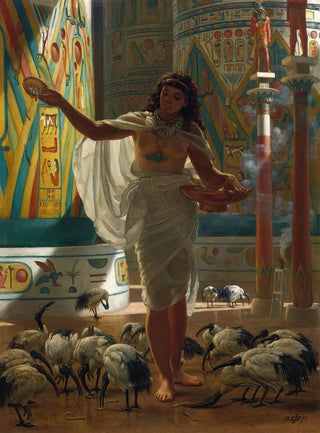Art print | Nourishing the sacred ibis in the halls of Karnak - Edward John Poynter


View from behind

Frame (optional)
In the fascinating world of art, some works transcend their era to transport us to distant and mysterious worlds. "Feeding the Sacred Ibis in the Halls of Karnak" by Edward John Poynter is one of those creations that captivates the mind and awakens the senses. This painting, a true ode to ancient Egypt, immerses us in the rites and beliefs of a civilization where the ibis, this sacred bird, was venerated as a symbol of wisdom and knowledge. Through this art print, the viewer is invited to explore not only the aesthetic beauty of the scene but also the rich history that accompanies it. Poynter's choice to depict this delicate moment, where the man feeds the ibis, evokes a communion between human and divine, a relationship imbued with respect and devotion.
Style and uniqueness of the work
Poynter's work stands out for its meticulous style and attention to detail. Every element of the composition, from the delicate feathers of the ibis to the adornments of the characters' clothing, demonstrates exceptional care. Light plays a crucial role, creating shadows and reflections that bring the scene to life. The colors, both vivid and harmonious, evoke the warmth of the Egyptian climate and the richness of its heritage. This art print does not merely depict an action; it tells a story, that of a frozen moment in time where nature and spirituality meet. The flowing lines and organic shapes reinforce this impression of movement, as if one could almost hear the whisper of the wind in the majestic halls of Karnak. Poynter thus manages to create an immersive atmosphere, inviting the viewer to imagine themselves within this sacred scene.
The artist and his influence
Edward John Poynter, an emblematic figure of the Pre-Raphaelite movement, knew how to marry tradition and innovation in his work. Influenced by the masters of the Renaissance, he also integrated contemporary elements, making his creations accessible while preserving a historical depth. His fascination with

Matte finish

View from behind

Frame (optional)
In the fascinating world of art, some works transcend their era to transport us to distant and mysterious worlds. "Feeding the Sacred Ibis in the Halls of Karnak" by Edward John Poynter is one of those creations that captivates the mind and awakens the senses. This painting, a true ode to ancient Egypt, immerses us in the rites and beliefs of a civilization where the ibis, this sacred bird, was venerated as a symbol of wisdom and knowledge. Through this art print, the viewer is invited to explore not only the aesthetic beauty of the scene but also the rich history that accompanies it. Poynter's choice to depict this delicate moment, where the man feeds the ibis, evokes a communion between human and divine, a relationship imbued with respect and devotion.
Style and uniqueness of the work
Poynter's work stands out for its meticulous style and attention to detail. Every element of the composition, from the delicate feathers of the ibis to the adornments of the characters' clothing, demonstrates exceptional care. Light plays a crucial role, creating shadows and reflections that bring the scene to life. The colors, both vivid and harmonious, evoke the warmth of the Egyptian climate and the richness of its heritage. This art print does not merely depict an action; it tells a story, that of a frozen moment in time where nature and spirituality meet. The flowing lines and organic shapes reinforce this impression of movement, as if one could almost hear the whisper of the wind in the majestic halls of Karnak. Poynter thus manages to create an immersive atmosphere, inviting the viewer to imagine themselves within this sacred scene.
The artist and his influence
Edward John Poynter, an emblematic figure of the Pre-Raphaelite movement, knew how to marry tradition and innovation in his work. Influenced by the masters of the Renaissance, he also integrated contemporary elements, making his creations accessible while preserving a historical depth. His fascination with






